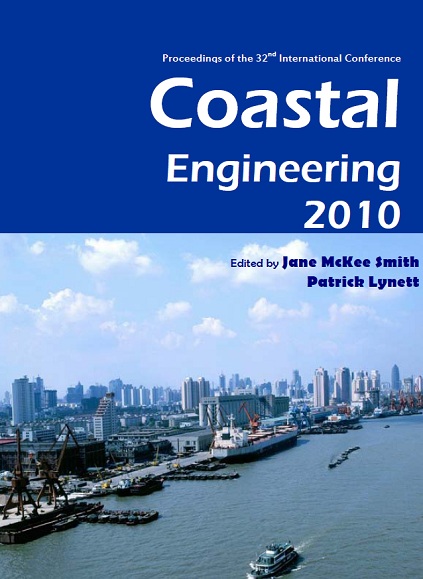Abstract
Port and harbor areas are vulnerable to tsunamis, because of high population and business activities as well as low-lying areas. Furthermore many vessels, containers and cars existing in the areas may be floated and drifted by a series of tsunamis. The tsunami-drifted bodies have the potential to collide with houses and buildings and then to cause secondary damage to them. In this study, a numerical model has been developed to estimate the behavior of multiple tsunami-drifted bodies. In the present model, a drifted body due to the tsunami is moved in terms of drag and inertia forces acting on the body, which are calculated with fluid velocity distributing on side faces of the body. Furthermore, a collision model is developed and integrated with the drift model, to consider that a drifted body collides with another drift body and a fixed body. A break model of mooring system is also developed and integrated with the drift model, by which a mooring vessel can start to be drifted when the mooring system is broken. The present model is qualitatively validated through conducting simple test runs, and applied to calculations in actual bathymetry and topography.References
Honda, K., and T. Tomita. 2008. Tsunami estimation including effect of coastal structures and buildings by 3d-model, Proceedings of 31 st International Conference on Coastal Engineering, ASCE, 1433-1445.
Ikeya, T., R. Asakura, N. Fujii, M. Ohmori, T. Takeda, and K. Yanagisawa. 2005. Experiment on tsunami wave force acting on a floating body and development of an evaluation method, Annual Journal of Coastal Engineering, JSCE, 52, 761-765 (in Japanese).http://dx.doi.org/10.2208/proce1989.52.761
Kawasaki, K., and M. Hakamata. 2007. Numerical analysis of time-changing wave force acting on drifting rigid structure with solid-gas-liquid phase flow model, Proceedings of the 30 th International Conference on Coastal Engineering, ASCE, 4507-4519.
Tomita, T., K. Honda, and T. Kakinuma. 2007. Application of three-dimensional tsunami simulator to estimation of tsunami behavior around structures, Proceedings of 30 th International Conference on Coastal Engineering, ASCE, 1677-1688.
Yoneyama, N., and H. Nagashima. 2009. Development of a three dimensional numerical analysis method for the drift behavior in tsunami, Journal of Coastal Engineering, JSCE, 56, 266-270 (in Japanesea).

